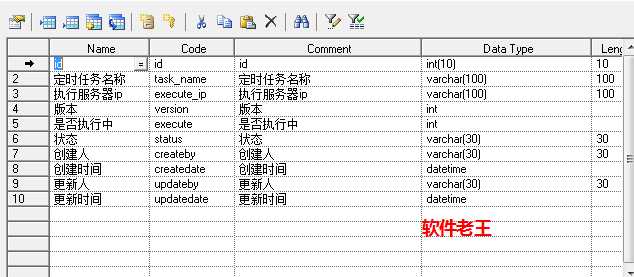多机部署之定时任务完整方案
Posted ruanjianlaowang
tags:
篇首语:本文由小常识网(cha138.com)小编为大家整理,主要介绍了多机部署之定时任务完整方案相关的知识,希望对你有一定的参考价值。
1.场景描述
老项目需要多机部署,项目中有几十个定时任务,一旦多机部署,定时任务就会重复执行,固定ip与错开时间方案都存在较大弊端,最终采用的方案是:AOP+排他锁的方式,软件老王已验证通过,介绍下,有需要的朋友可以参考下。
2.解决方案
软件老王基本方案是采用:AOP+排他锁的方式。
(1)目前老项目有几十个定时任务,采用AOP的方式,可以保证代码的无侵入(即使简单的微侵入,例如增加几行代码,测试验证的工作量也会比较大的)。
(2)采用排他锁的方式,保证批处理的高可用,不重复执行。
2.1 AOP编程
Aop的概念就不说了,就是面向切面编程,通俗点就是统一处理一类问题,比如日志、请求鉴权等,刚开始不确定是否可行,系统中的批处理是使用spring注解的方式@Scheduled进行批处理,采用aop对注解@Scheduled进行编程,统一拦截批处理,代码如下:
/**
* 软件老王-AOP处理类
*/
@Aspect
@Component
public class ScheduledAspect {
@Autowired
ScheduleService scheduleService ;
@Pointcut( "@annotation(org.springframework.scheduling.annotation.Scheduled)")
public void scheduled() {
}
@Around("scheduled()")
public Object scheduled(ProceedingJoinPoint pjd) {
Object result = null;
String taskName = pjd.getSignature().getName();
try {
if (scheduleService.isInvoke(taskName)){
return result;
}
result = pjd.proceed();
scheduleService.end(taskName);
} catch (Throwable e) {
throw new RuntimeException(e);
}
return result;
}
}
说明:
(1)面向标签编程
@Pointcut( "@annotation(org.springframework.scheduling.annotation.Scheduled)")这样注解会拦截标签@Scheduled。
(2)使用aop的环绕标签 @Around("scheduled()")
@before标签拿不到执行完成状态,需要使用环绕标签@@Around,在标签中可以拿到执行完成后状态,以便放开锁。
result = pjd.proceed();(3)结合排他锁使用
@Autowired
ScheduleService scheduleService ;2.2 排他锁
排他锁,简单来说就是通过数据库总的标志位+版版号进行的控制.
软件老王的代码如下,:
/**
* 软件老王-排他锁服务类
*/
@Service
public class ScheduleService {
@Autowired
ScheduleClusterMapper scheduleClusterMapper;
public boolean isInvoke(String taskName) {
boolean isValid = false;
try {
ScheduleCluster carIndexEntity = scheduleClusterMapper.selectByTaskName(taskName);
int execute = carIndexEntity.getExecute();
String ip = InetAddress.getLocalHost().getHostAddress();
long currentTimeMillis = System.currentTimeMillis();
long time = carIndexEntity.getUpdatedate().getTime();
if (execute == 0) {
isValid = start(taskName, carIndexEntity.getVersion(), ip);
}
} catch (UnknownHostException e) {
e.printStackTrace();
}
return isValid;
}
//执行锁机制,软件老王
public boolean start(String taskName, int version, String ip) {
ScheduleCluster scheduleCluster = new ScheduleCluster();
scheduleCluster.setVersion(version);
scheduleCluster.setExecuteIp(ip);
scheduleCluster.setUpdatedate(DateUtil.getCurrentTime());
scheduleCluster.setTaskName(taskName);
scheduleCluster.setExecute(1);
int count = scheduleClusterMapper.updateByTaskName(scheduleCluster);
if (count > 0) {
return true;
}
return false;
}
//执行解锁机制,软件老王
public void end(String taskName) {
ScheduleCluster scheduleCluster = new ScheduleCluster();
scheduleCluster.setUpdatedate(DateUtil.getCurrentTime());
scheduleCluster.setTaskName(taskName);
scheduleCluster.setExecute(0);
scheduleClusterMapper.updateNormalByTaskName(scheduleCluster);
}
}说明:
大的原理是在where条件后带上版本号,在update中更新version+1,这样通过影响数据库的影响条数,来判断是否拿到锁。
(1)主类中调用start方法,该方法是更新批处理状态,软件老王这里设置了一个小点,在updateByTaskName的mybatis方法中,有个version+1的更新;
(2)end方法放在更新完成后,释放锁。
(3)其实还有一个点,可以考虑下,需要有个机制,比如出现异常情况,刚好批处理执行中,重启服务了等,下次批处理执行前,假如锁还未释放,代码中增加释放锁的机制。
2.3 数据库相关
(1)数据库表设计

(2)mybatis相关方法
(1)第一个是start对应方法,执行锁和version增加。
<update id="updateByTaskName" parameterType="com.yutong.dmp.entity.ScheduleCluster">
update t_schedule_cluster
<set>
<if test="executeIp != null">
execute_ip = #{executeIp,jdbcType=VARCHAR},
</if>
<if test="version != null">
version = #{version,jdbcType=INTEGER} + 1,
</if>
<if test="execute != null">
execute = #{execute,jdbcType=INTEGER},
</if>
<if test="status != null">
status = #{status,jdbcType=VARCHAR},
</if>
<if test="createby != null">
createby = #{createby,jdbcType=VARCHAR},
</if>
<if test="createdate != null">
createdate = #{createdate,jdbcType=TIMESTAMP},
</if>
<if test="updateby != null">
updateby = #{updateby,jdbcType=VARCHAR},
</if>
<if test="updatedate != null">
updatedate = #{updatedate,jdbcType=TIMESTAMP},
</if>
</set>
where task_name = #{taskName,jdbcType=VARCHAR}
and version = #{version,jdbcType=INTEGER}
and status ='1'
</update>(2)第二个是释放锁,更改excute为0。
<update id="updateNormalByTaskName" parameterType="com.yutong.dmp.entity.ScheduleCluster">
update t_schedule_cluster
<set>
<if test="executeIp != null">
execute_ip = #{executeIp,jdbcType=VARCHAR},
</if>
<if test="version != null">
version = #{version,jdbcType=INTEGER},
</if>
<if test="execute != null">
execute = #{execute,jdbcType=INTEGER},
</if>
<if test="status != null">
status = #{status,jdbcType=VARCHAR},
</if>
<if test="createby != null">
createby = #{createby,jdbcType=VARCHAR},
</if>
<if test="createdate != null">
createdate = #{createdate,jdbcType=TIMESTAMP},
</if>
<if test="updateby != null">
updateby = #{updateby,jdbcType=VARCHAR},
</if>
<if test="updatedate != null">
updatedate = #{updatedate,jdbcType=TIMESTAMP},
</if>
</set>
where task_name = #{taskName,jdbcType=VARCHAR}
and status ='1'
</update>I’m 「软件老王」,如果觉得还可以的话,关注下呗,后续更新秒知!欢迎讨论区、同名公众号留言交流!
以上是关于多机部署之定时任务完整方案的主要内容,如果未能解决你的问题,请参考以下文章